Webinar Marketing Strategy: How to Market a Webinar Guide
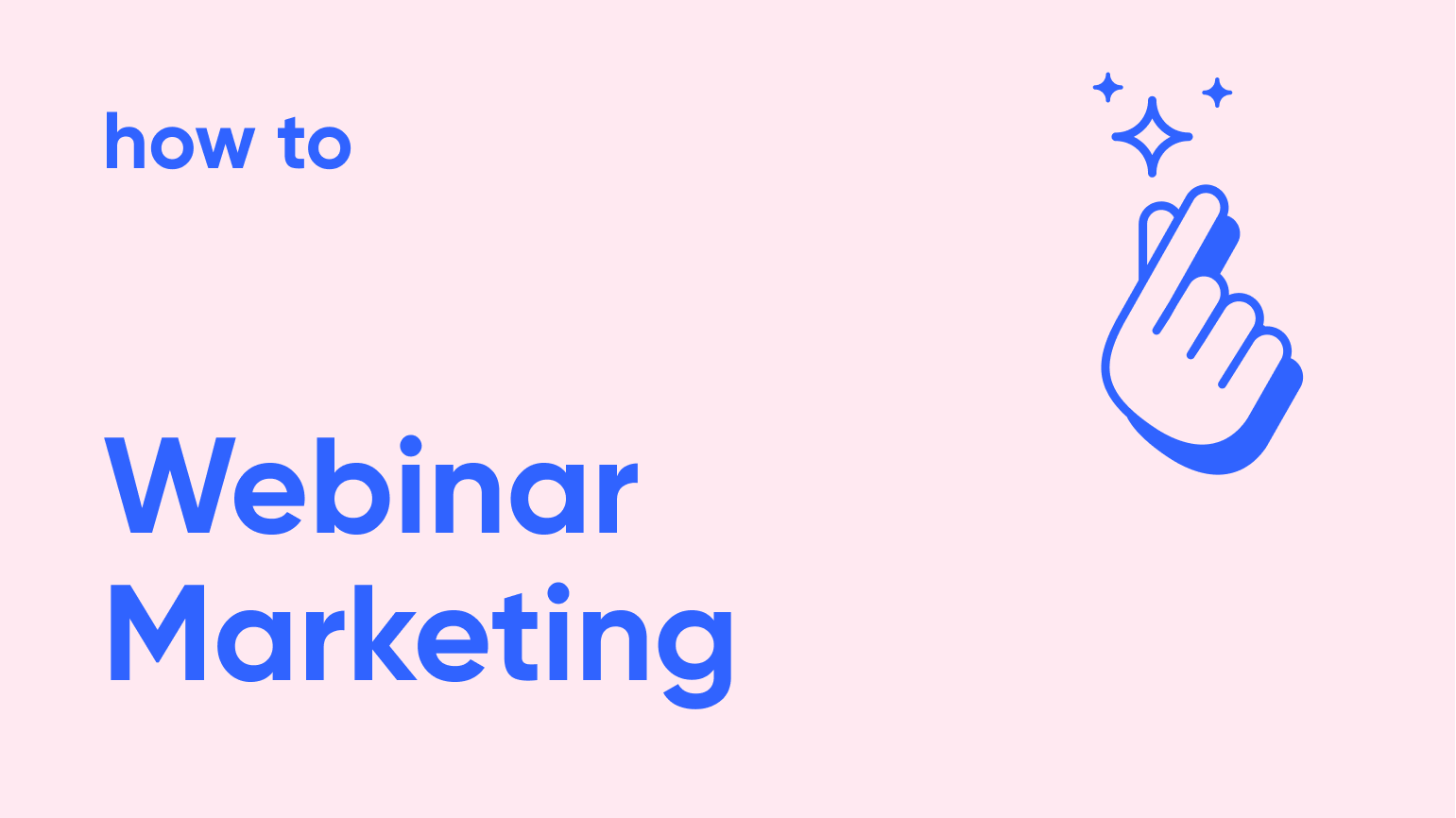
Webinars are a key strategy for almost every marketer. They’re popular because webinars can effectively turn an audience into leads and customers. In turn, this makes webinar marketing a crucial aspect for many businesses.
In this blog, we'll explore how to market a webinar you're hosting. We’ll start by covering why webinar marketing is crucial and then give you step-by-step instructions for building a high-converting webinar promotion plan. By the end, you will have all the information and tools you need to confidently hit your company's goals.
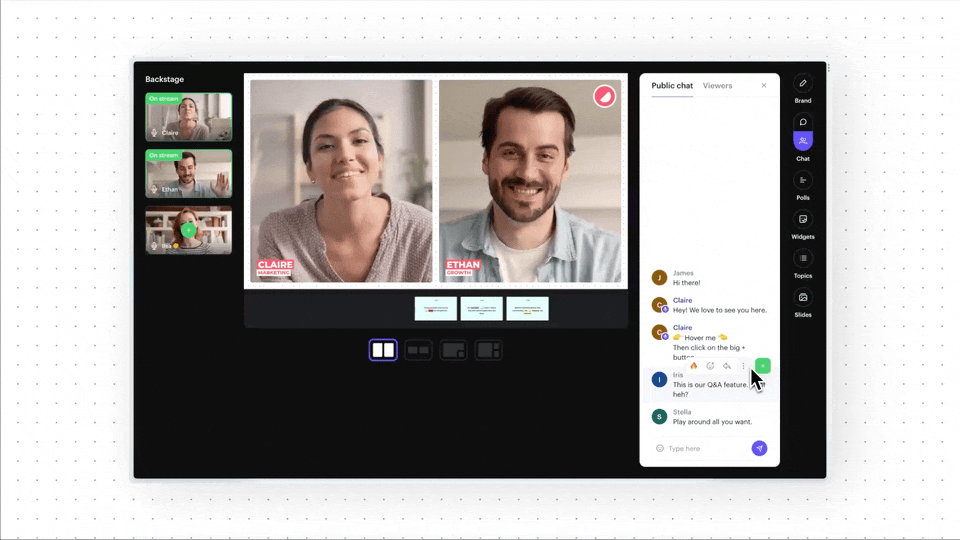
5 reasons why webinar marketing is important
Here's why webinars are such a hit among marketers:
- Expand your reach with fewer costs
Webinar marketing helps you reach a wider audience. Unlike in-person events, webinars can be attended by individuals from all over the world. This allows you to connect with a larger group of like-minded people. You can share your expertise and showcase your products or services to these individuals. Free webinar tools can help you to grow your audience without worrying about location or travel costs.
- Increased engagement
Webinars are a perfect platform for creating engagement. With features like live polls, Q&A sessions, and chat discussions, you turn a typical one-way presentation into a dynamic two-way conversation. People love being part of something interactive! When your audience can ask questions, share opinions, and participate in real-time, they feel more involved and invested in what you're sharing. This active involvement keeps people interested and engaged throughout the session, which is much harder to achieve with passive content like blogs or videos.
- Generate high-quality leads
Webinars are an excellent tool for lead generation. When someone registers for your webinar, they're essentially raising their hand and saying, "I’m interested in what you have to say!" You’re offering them value upfront—whether it’s expert knowledge, tips, or insights—and in exchange, they give you their contact information. This allows you to build a list of high-quality leads who are already interested in your niche or industry.
- Acquire data
Webinars provide a wealth of valuable data about your audience. When someone registers for your webinar, you can collect information like their name, email address, and company. You can also ask specific questions to learn more about their interests and needs. During the webinar, track their engagement, like how long attendees stay and what questions they ask. After the webinar, you can analyze this data to understand your audience better. For example, use lead scoring to identify and inform your sales team about the most interested leads.
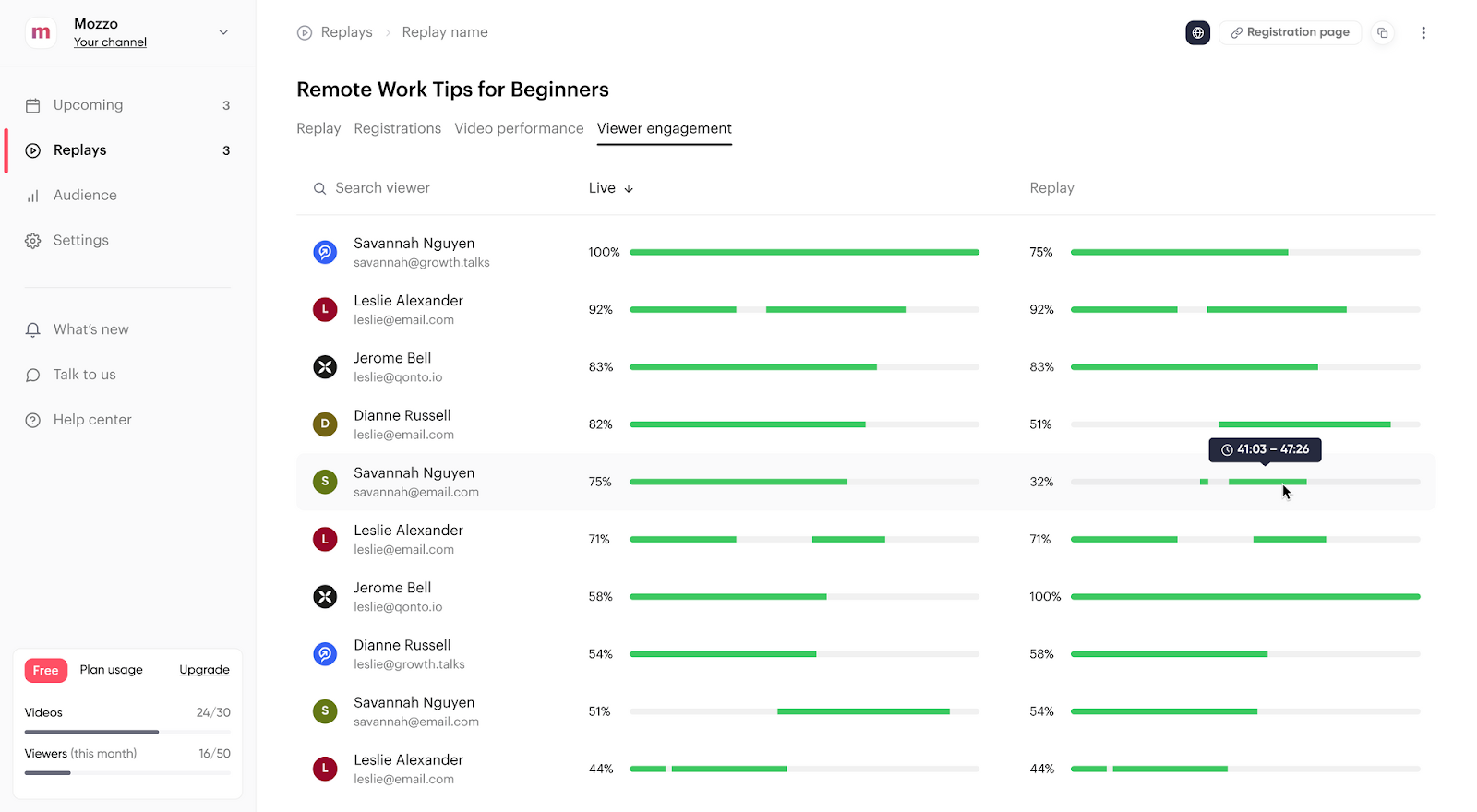
Showcase your expertise when hosting webinars lets you demonstrate your knowledge. Dive deep into topics that matter to your audience. This not only educates your viewers but also shows that you know what you’re talking about. When they see you as an expert, they are more likely to trust your brand. This can lead to stronger relationships and more business opportunities.
Before diving into the marketing plan, ensure you have a solid foundation. Our webinar guide covers everything from topic selection to post-event follow-up.
Creating a webinar marketing plan
As marketers, sometimes we overcomplicate our strategies and plans. But you also can't just send out random webinar invitations. A webinar marketing plan broadly has four stages: pre-webinar planning, webinar promotion, webinar execution, and post-webinar marketing. This section reviews each stage of digital marketing and explains what’s needed to make them successful.
Pre-webinar planning
Extensive planning is essential for webinars. A successful webinar marketing plan relies on checklists and pre-planning activities. These are discussed in detail.
Understanding your customers = understanding your content
Knowing your audience is key to creating a webinar that resonates. This means understanding what your audience likes, wants, and struggles with. Consult subject-matter experts like employees working on your products or key customers. Sitting in on sales calls can also help you understand your customers at a granular level. Get data from apps you might already use, like Google Analytics, your CRM, or your social media channels. If all else fails, look at our list of 17 B2B Webinar Ideas for inspiration.
Knowing your goals
What do you want from this webinar? Is it more sales? Is it building an audience? Is it purely informational? Having clear goals will help you better target your content to the right people at the right time. If your goal is to increase sales, focus on highlighting how your product/service solves problems for your audience. Create engaging and valuable content that attracts more viewers. If your webinar is informational, make sure your content is clear and provides useful insights. Setting clear goals helps you plan effectively and tailor your webinar to meet your audience's needs.
Identifying KPIs that matter
If you understand your customers and your goals, you should be able to measure your success. Common webinar KPIs include increasing click-through rates (CTRs), total registrations, total attendees, and conversions. Understanding your webinar goals helps you focus your efforts and resources effectively. Developing clear goals leads to better performance and higher success rates. Tracking your most important KPIs helps you see what works and what needs improvement.
Choosing the right webinar tools
The right tools can free you up to make important strategic and content decisions to meet your KPIs. The best webinar platforms can make your webinars more compelling and significantly impact your conversions. We built Contrast to make webinars more interactive and have a bigger impact on sales. Learn how it does just that by checking out our features.
Recruiting speakers and a support team:
Pick the right individuals to present and run the webinar. If you wish to hire a guest speaker, ask them these essential questions first. The different roles during a webinar include an organizer/facilitator, presenter, and assistant. The organizer handles logistics and ensures the webinar runs smoothly. The presenter delivers the main content and engages with the audience. The assistant helps with technical issues and manages the chat or Q&A sessions. Having the right team in place makes your webinar more professional and effective.
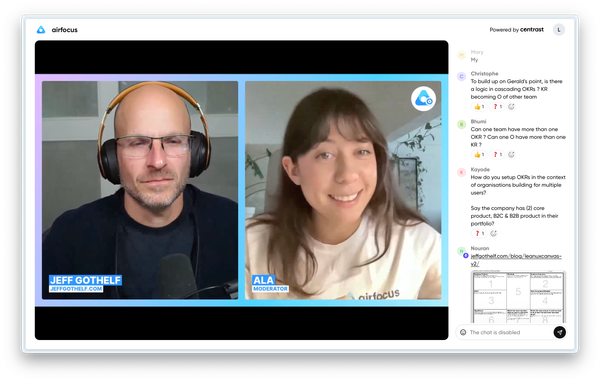
Webinar promotion
All your preparation work won’t amount to much unless you promote your content to the right audience. An effective webinar promotion plan involves a few steps:
Driving registrations
After you confirm the date and time, setting up a high-converting registration page is crucial for driving sign-ups. A good webinar registration page has several parts working together. A snappy headline sets the tone. A concise and helpful description gives visitors the information they need and branded visuals help your company stand out.
Userled created a great webinar page with these elements:
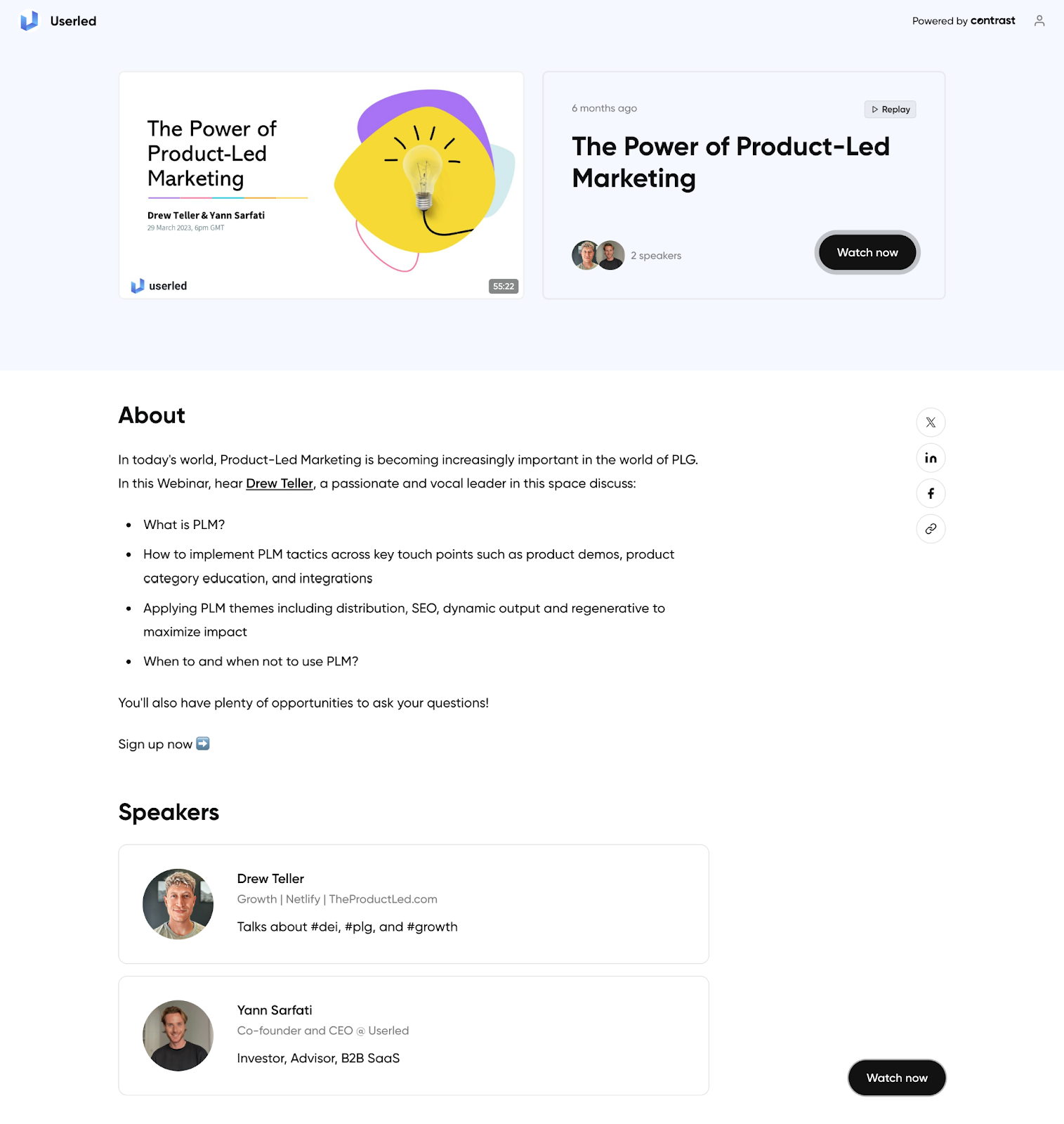
A webinar registration page build on Contrast by Userled
Here are a few things make this page an excellent example:
- A clear headline and a concise description with bullets helps to easily consume the information.
- The banner image matches the customer’s branding.
- Speaker information establishes credibility.
- Clear CTA buttons.
We built Contrast so you can easily build compelling and beautiful registration pages. With a few clicks, you can have a crisp and clear description, branded visuals, and speaker information up and running. It’s recommended that you give around 3-4 weeks to promote your webinar after the registration page is up. This is because while 59% of registrants sign up for webinars on the week it is scheduled, the remaining 41% sign up beforehand.
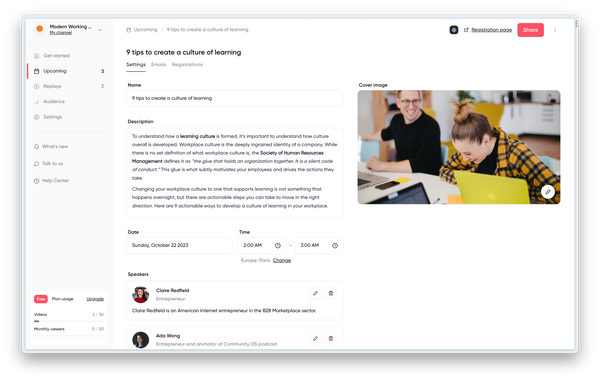
Creating promotional assets
The ideal forums to promote your webinar depends on your audience and must be considered when developing your webinar marketing plan. For example, LinkedIn is more likely to attract B2B attendees than TikTok. But, most marketers prefer email as it converts 27% more than any other channel.
While you can follow our email sequence guide for more details, here’s a list of tactics you can follow.
- Segment your customers: Don’t use just one list. Organize email lists based on the customer’s buyer stage and set up personalized email sequences dedicated to each segment—a free email template builder will streamline the process. Addressing their problems and challenges will get their interest.
- Create professional, attention-grabbing headlines: Time is precious. Explain what attendees can expect and why your webinar is a must-see event.
- Get attendees to save the date: Inform attendees to keep their time slots free at least a couple of weeks in advance. Provide incentives like lower-priced tickets for paid webinars or use tools and extensions to help block off their calendars.
- Highlight speakers and topics: Experiment by spotlighting different speakers/panelists, topics covered, and potential takeaways for participants.
- Share behind-the-scenes updates: To build hype, share sneak peeks of how your webinar is coming along, and even share previews of what to expect in presentations.
- Send emails on key dates: Inform attendees about your webinar without overwhelming them. Consider sending emails 7 days, 3-4 days prior, and on the day of the webinar to optimize your webinar marketing strategy.
Involve your sales and wider teams
Webinars serve your entire company. Learn how to get your sales and custom success teams involved in your webinar's digital marketing tactics. Collaborating with these departments should be part of your webinar marketing strategy. Input from these teams can help build great content and ensure consistent messaging. Schedule a meeting to help align your objectives. Discuss shared goals like increasing brand awareness, attracting high-quality leads, and converting free trial users into paying customers. Sales can provide insights on challenges like customer churn. Customer success can suggest relevant testimonials and case studies to highlight. Additionally, they will also extend your webinar's reach, as they can promote events to their contacts. For even more reach, they can have the registration link on their email signature.
Co-promoting with guest speakers
If you have guest speakers, co-promoting with them is a useful tool in your webinar marketing plan. If the speaker is an expert in the field, they can help bring new sign-ups to your webinar. Invite the speaker to include the link to your registration page in their newsletters, website, and social media posts.
Tap into social media
Social media is a must-have when thinking about how to market a webinar. While there are many engaging content ideas to choose from, look into the points below for guidance.
- Identify the platforms your audience frequents. For instance, if you’re targeting individuals under 25, Instagram or TikTok might be more effective than Facebook.
- Share posts about the webinar topic, speakers, and examples early and frequently.
- Use paid social media advertising to improve reach among targeted segments who match your webinar's focus.
- Use video snippets of speakers discussing key points as shareable content.
- Make Twitter (better known as ‘X’) and LinkedIn polls to gauge interest in the topic and stimulate discussion.
- Consider hosting a live AMA (ask me anything) session with experts.
- Participate in industry conversations using relevant hashtags and joining groups.
- Pin posts about your webinar to the top of your feed so it can be seen easily.
- Encourage registrants to promote your webinar by providing tools for easy social sharing. If possible, offer incentives for referrals and sign-ups.
Bonus: Use social proof in your webinar marketing strategy
Highlighting endorsements from past attendees can boost your credibility and encourage new registrations. Consider adding these to your registration page or promotional emails. If past attendees have seen value in your webinars, their positive experiences could persuade others. You may encourage attendees to share their thoughts and questions about your webinar using a dedicated hashtag or on a particular group. This content makes your webinar marketing feel more authentic and makes it easier for individuals to find and join the conversation.
Emails and social media are important for promotion but aren't enough without a comprehensive webinar promotion plan. If you're wondering how to market a webinar effectively, check out this detailed guide to promoting your webinar for a full list of channels and tactics to use.
Webinar execution
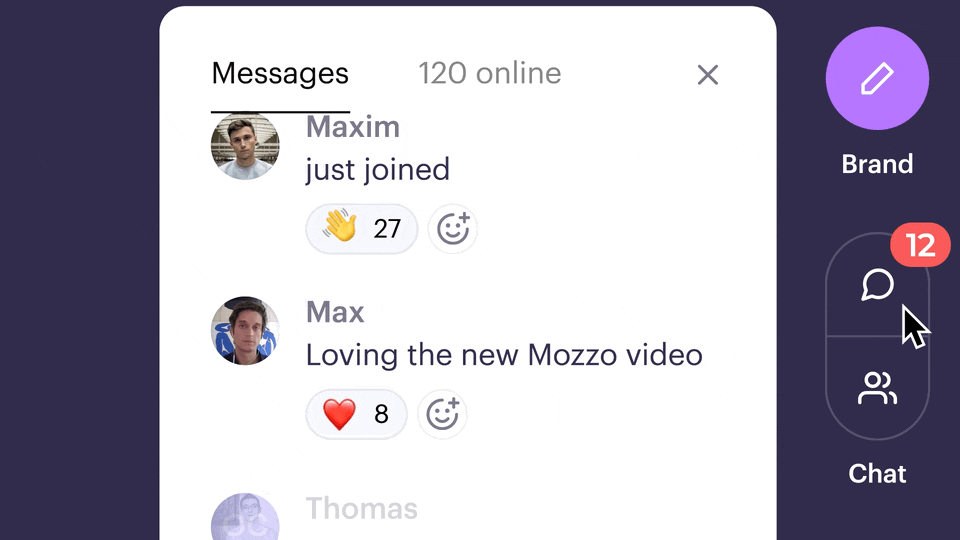
Your webinar should live up to, or even exceed, your audience’s expectations. Here’s how to do it.
Getting ready for the webinar
You could host your webinar from a basement with poor lighting and a messy background. But, the best webinar hosts prepare beforehand with rehearsals, preparing outlines, having backups, and conducting dry runs. Setting up cameras, microphones, and lighting ensures a more inviting experience for attendees. There are a few things you can do to improve your webinar setup and make it look great on camera with a limited budget. For example, use natural light or inexpensive lamps to brighten your space. Clean up your background to make it look professional. Test your equipment to avoid technical issues during the event.
Personalize your webinar
A big part of getting ready is aligning your webinar’s branding with your marketing assets. Older webinar tools make branding difficult. You’ll want to fully customize the look of your webinar to help it stand out. Modern webinar platforms like Contrast make it easy to customize the visual elements. Adjust the overall look and feel to specifics like slide layouts, themes, and widgets. This helps make your presentation more professional. The next section mentions interactive features like polls and Q&A sessions to keep your audience involved. Customizing these elements ensures your webinar stands out, captures, and maintains their attention.
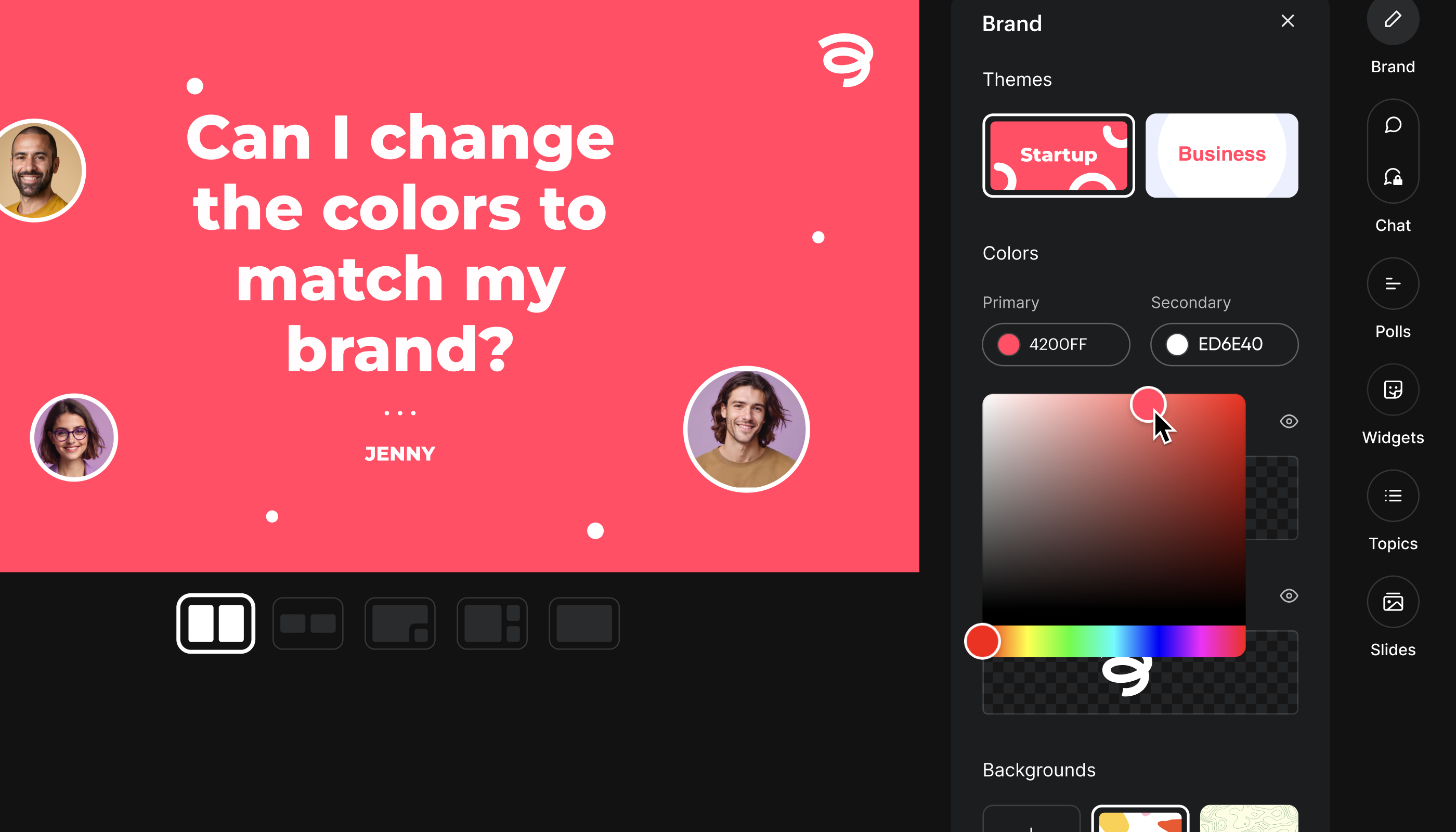
Presenting the Webinar
If you have prepared well, your webinar should go smoothly. By using tools like slide decks, polls, chats, and well-placed CTAs, you can create a webinar that informs, engages, and converts.
Polls are one way to create engagement among attendees. Asking a question lets people express their thoughts on your topic. Contrast lets you easily create polls by clicking the “Polls” button on the right panel.. Once done, sit back and watch the results roll in!
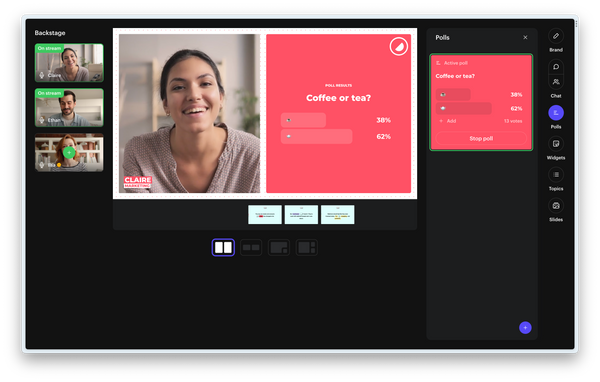
You can even overlay the final poll results over the screen so that your audience can see them. We believe that EVERY webinar should be compelling, which is why all of our engagement features are included in our free plan. Create a free account to check them out.
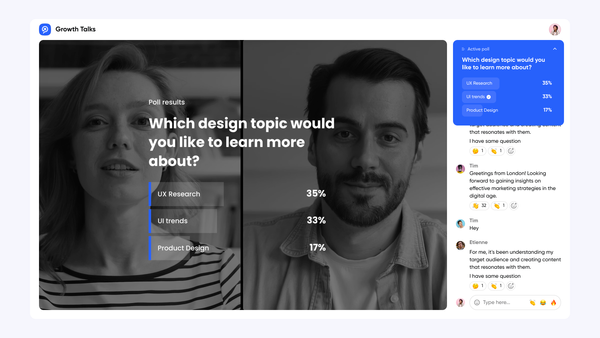
Remember to engage with your audience's responses in Q&A sessions and chats as well.Audience interaction is a key source for new ideas and future webinars. Remember that attendees who interact during a webinar are more engaged and more likely to convert. If possible, have a teammate on standby during the webinar. They can highlight audience interaction in the chat that presenters might miss while hosting.
Post webinar marketing
Knowing how to market a webinar ensures your strategy doesn’t end when the presentation is over. The goal of post-webinar activities is to nurture your relationship with your attendees. Start with a “thank you” email immediately after the webinar wraps up. Include the on-demand recording link for those who couldn't attend or want to revisit the content. Then, focus on fostering the relationship with helpful follow-ups. Furthermore, conduct a post-webinar survey to gather feedback. This helps you understand what worked and what can be improved for future webinars.
Nurture campaigns
A thorough follow-up strategy is crucial to turn attendees into customers. You should have a well-crafted email sequence ready to go. Engage your audience with helpful information to guide them in their buyer's journey. Move them down the funnel with targeted blogs and videos that address their most important issues. Use case studies to show real-world success stories. Offer personalized deals that match their interests. Follow up promptly to keep the conversation going. These methods help build trust and encourage attendees to take the next step.
Reuse content
Repurposing your webinar makes it easy to create more marketing assets to support the post-webinar marketing stage. This could mean video recaps, carousel posts, images, infographics, blog posts, video clips, testimonials or any other format. Repurposing gets the most out of your webinar to generate new views and leads, making it a key part of your webinar marketing strategy.. Doing this effectively can provide months of useful content. This is important when you realize 63% of webinar views are on-demand.
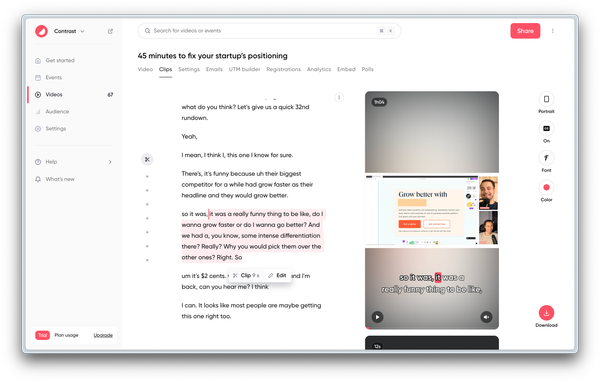
With Contrast, you can repurpose your webinar in multiple ways. To start, every webinar automatically turns into an on-demand webinar. It can be replayed from the same link so that every registrant has access. We even create chapters to make your webinar replays easier to navigate. If you prefer, use our Repurpose AI to help you draft a newsletter article, or discover 15 ways to use AI to repurpose your webinar.
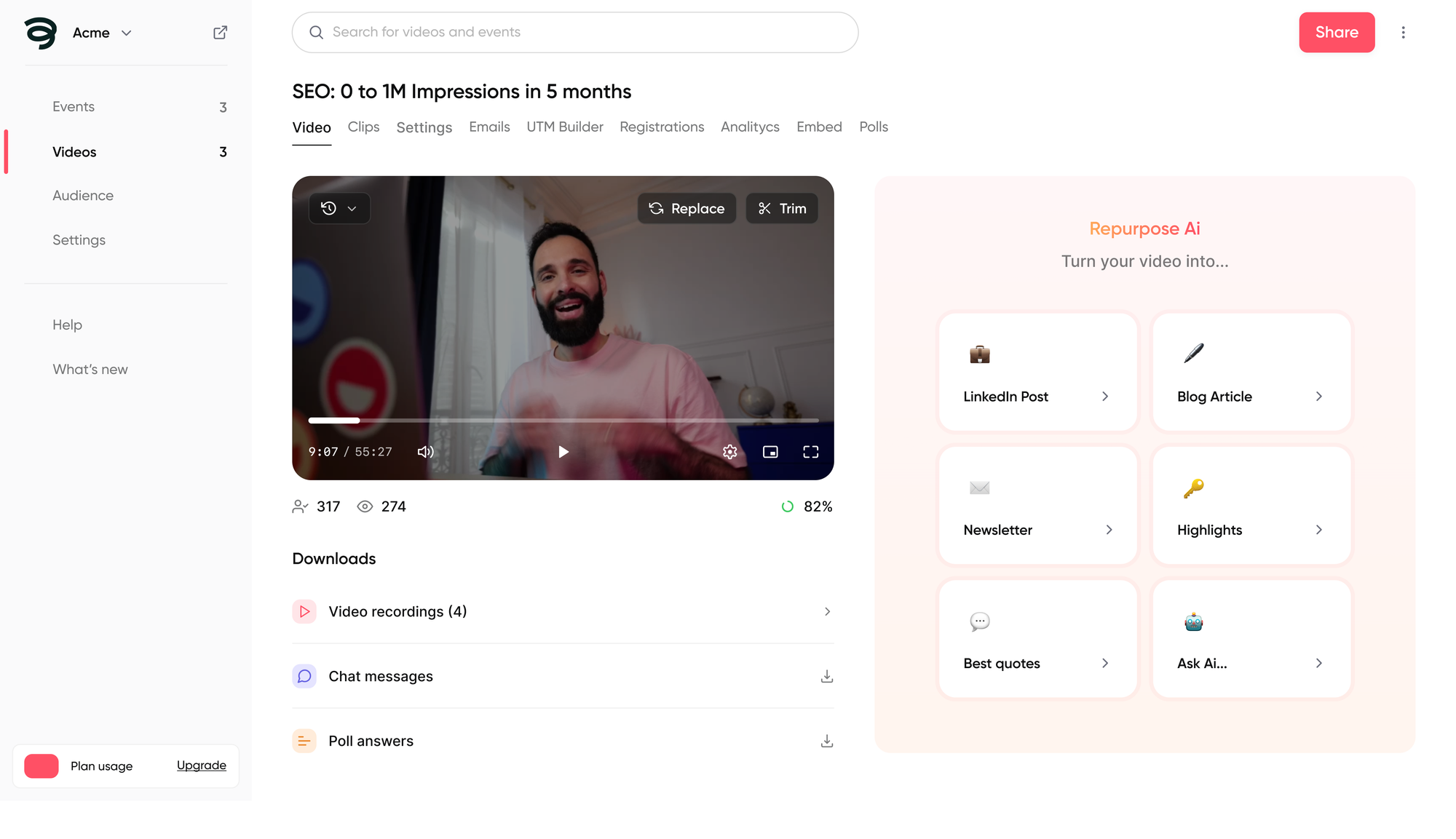
You can also use Contrast to edit and share short-form video clips, which helps to better execute your webinar marketing plan. That gives your marketing team a supply of high-quality content. This can be shared across other marketing channels like social media, your website, and future sales and marketing emails, helping you refine your webinar marketing strategy.
How to measure the success of webinar marketing
Reviewing webinar metrics helps you spot what worked and what didn't. Some common benchmarks webinar marketers uses to measure success include:
Number of registrations
This is the number of people who registered for your webinar. It gives a good understanding of the effectiveness of your registration page and webinar promotion plan. A high number of registrations may indicate that your webinar marketing plan is highly effective. Conversely, a low number of registrations may suggest that you need to refine your promotional strategies. Track this metric to better identify what works and what needs improvement. This helps you optimize future webinars for better results.
Source of webinar registrations
The analytics in your webinar platform should show how attendees found your webinar. This lets you understand which marketing channels were effective for your webinar marketing strategy. By knowing where your audience is coming from, you can focus more on those successful channels. You can also identify gaps that need improvement. For example, if social media isn't driving much traffic, you might need to adjust your approach there. Tracking these sources helps you refine your webinar promotion plan.
Registration page conversion rate
This is the ratio of people who have registered versus the number of people who have visited your registration page. For example, if you’re driving a lot of traffic to your registration page but they’re not signing up, it could mean you’re promoting your webinar to the wrong audience or your registration page is not compelling enough. A low conversion rate suggests that you need to improve your registration page's design, messaging or both. Make sure your registration page clearly explains the benefits of attending the webinar. Use strong CTAs to encourage sign-ups.
Attendance rate
This measures how many people actually watched your live webinar versus those who registered for it. It also assesses how well you reminded registrants to show up. WebinarNinja reports that a good attendance rate is around 35-45%. If your attendance rate is lower, you might need to improve your reminder emails. Send timely reminders to keep your event top-of-mind. Consider offering incentives for attending, like exclusive content or discounts.
Attendee drop-out ratio
This measures how long attendees stay in your webinar. If attendees leave early, it might indicate that your content is not engaging or valuable. A high drop-out rate suggests that you need to improve your presentation. Ensure your content is relevant, interesting, and presented well to your audience. Keep your audience's attention by varying your presentation style. Consider breaking your content into shorter, more digestible segments. Monitor when attendees start to drop off to identify any weak points in your webinar.
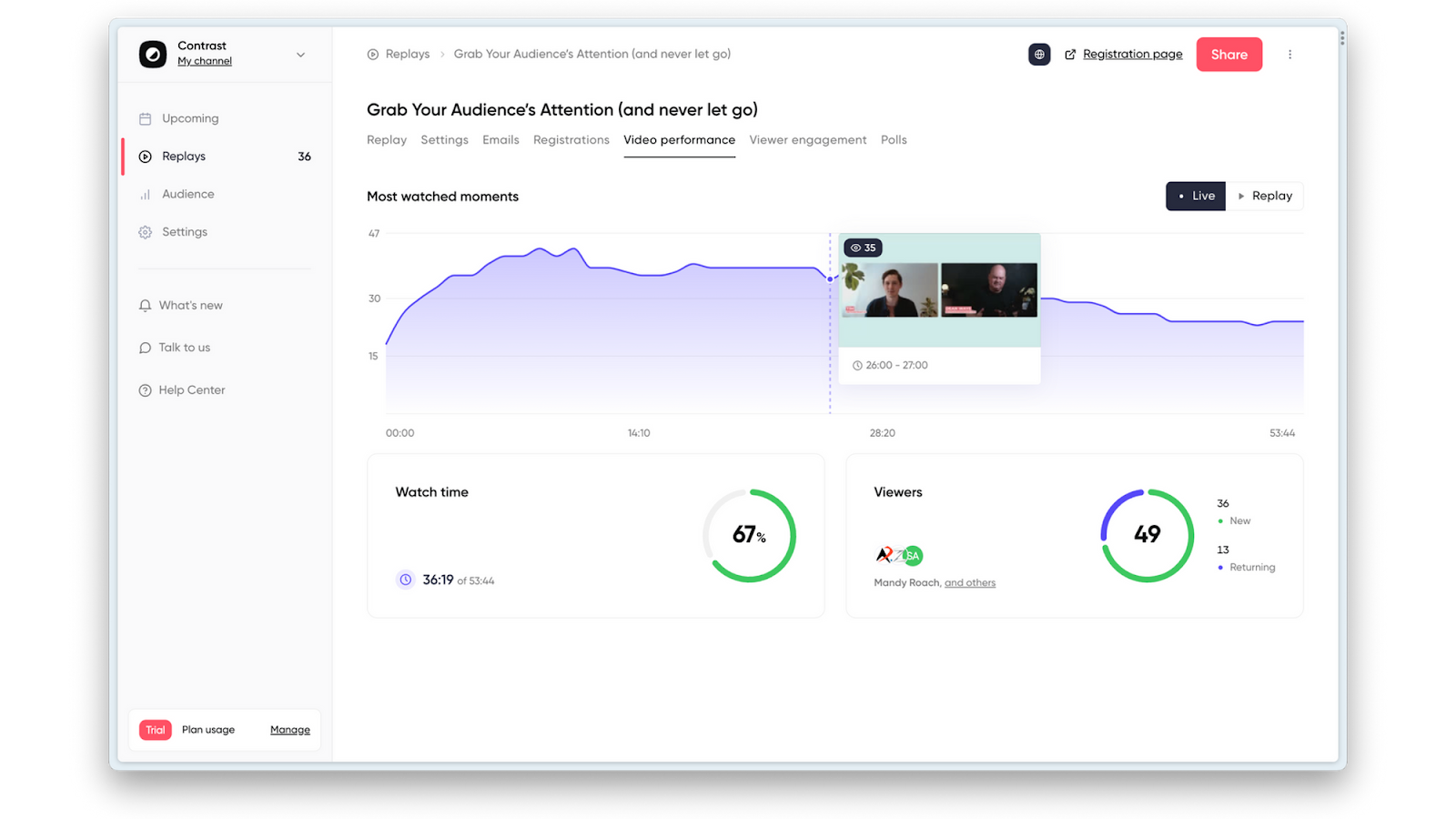
Conversion rate
This is the percentage of attendees who perform a particular action. Every company measures conversions differently. You might even measure conversions across each of your webinars depending on its ultimate goal. It could be anything from a product sign-up, booking a demo, scheduling a meeting, or buying a product/service.. Understanding your conversion rate helps you see how effective your webinar is at driving action. A high conversion rate indicates that your content and CTAs are compelling. Try out our Webinar ROI calculator to determine the success of your webinar.
Contrast’s free webinar analytics gives a clear view of how your webinars are performing. This makes it a key part of your webinar marketing plan. In turn, analytics are essential for effective webinar marketing. Track all of the KPIs mentioned above and discover what moments attendants liked and what needs improvement in your overall webinar marketing strategy.
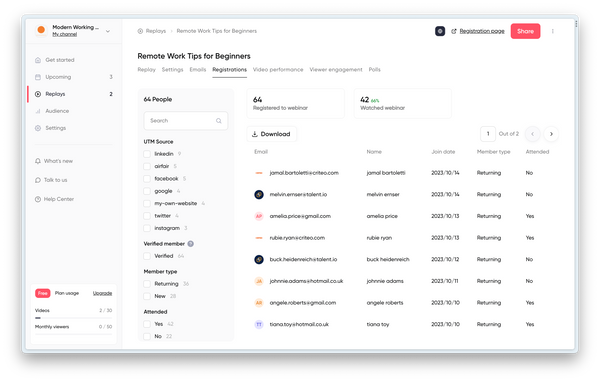
Webinar marketing tools: why you should use Contrast
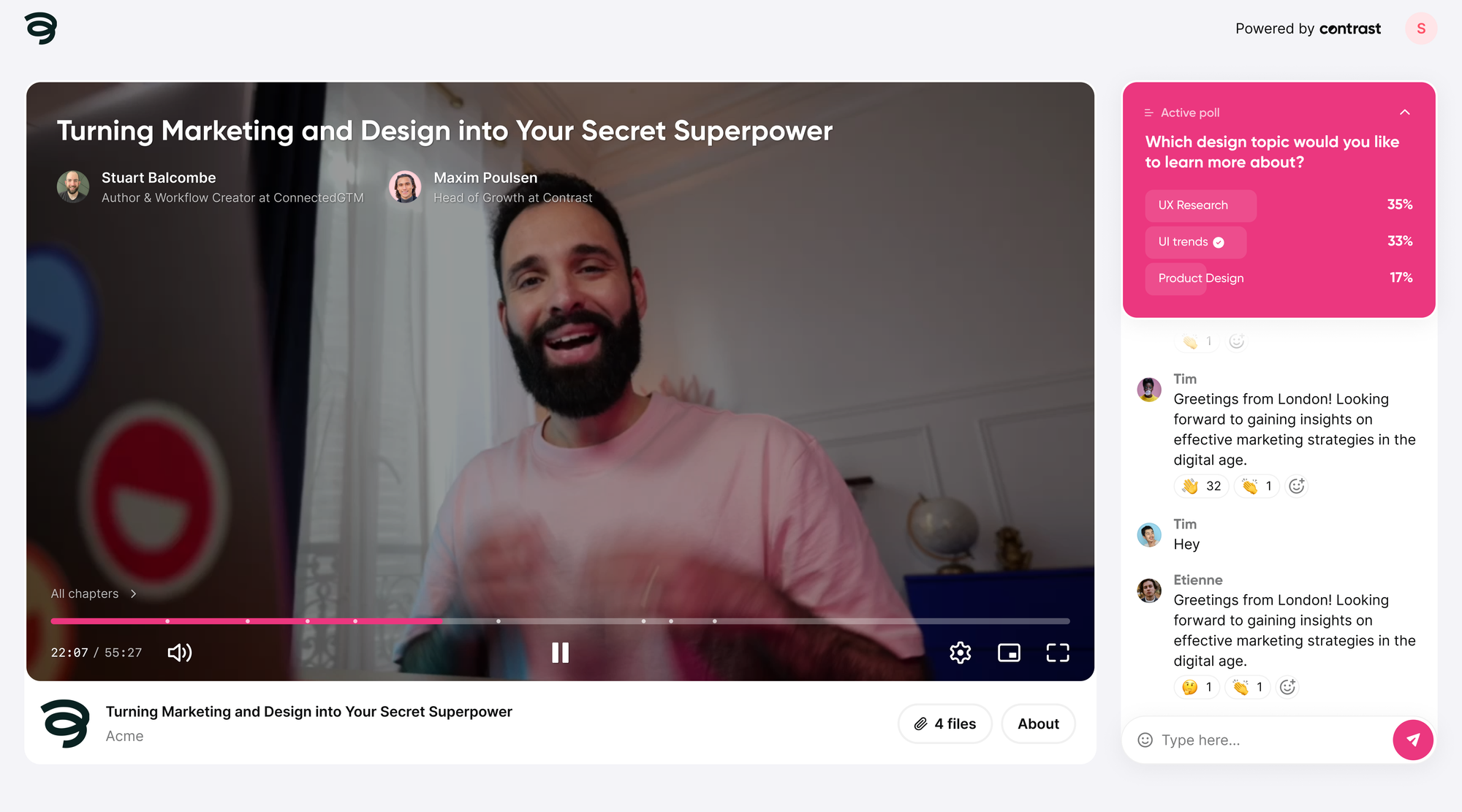
There are a lot of webinar marketing tools to choose from. Many are free. Comparing them all and making a choice can be overwhelming. But we think Contrast stands out as the top choice for lively, compelling, and authentic webinars.
Key features:
- Unlimited seats
- Modern chat interface
- Engaging Q&A and poll features
- Custom branding
- Dynamic themes and prebuilt layouts
- On-screen widgets like trending messages and tickers
- Extensive integrations with tools like HubSpot, Zapier, and Make
- Built-in transcripts and editing features to repurpose webinar content with AI assistance
- Rich analytics and reporting
It goes above and beyond the basic features that most webinar platforms offer. You can create and customize the entire webinar experience quickly. Personalize everything from registration pages to the layout and visuals in your webinar. A back-end webinar studio even allows you to edit and share clips for content repurposing.
Customer testimonial: How airfocus uses Contrast for content
airfocus, a company developing software for product managers, captured more leads with Contrast than with their previous platform, Livestorm. Contrast's Repurpose AI feature saved hours by quickly turning webinars into blog articles, video clips, and social media posts. This allows them to focus on strategy and creativity, with the company’s Head of Marketing adding that “At least 75% of the blog articles we write from our webinars are assisted by Repurpose AI…”
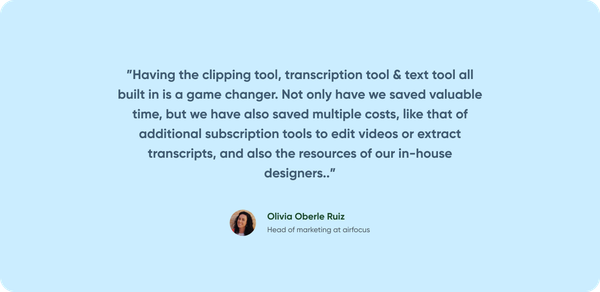
Contrast's Webinar Studio and easy-to-use interface made setting up registration pages simpler, saving them an hour of work per webinar. The integration with HubSpot streamlined managing attendee lists, allowing for more personal follow-ups by the sales team. Due to better engagement with Contrast's features, about 65% of webinar attendees became MQLs. The repurposed content solidified airfocus's position as a thought leader, attracting more prospects and customers.
Customer testimonial: How Alleo 2x’d registrations and increased attendance by 42%
Webinars play a key role in Alleo's acquisition strategy, with about 60% of their pipeline being introduced to a webinar. They now get up to 1,000 registrations for some webinars.
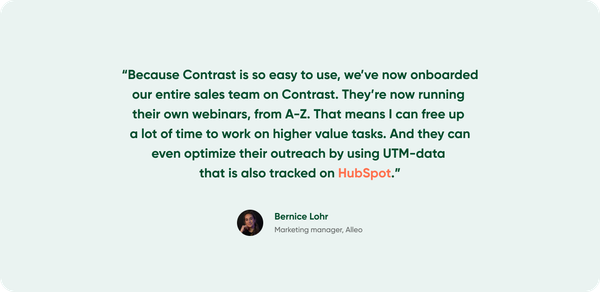
Furthermore, they also mentioned that the HubSpot integration has been particularly valuable, providing over 20 data points. These help the sales team have more relevant conversations with prospects. On average, Alleo now has 400 attendees per webinar, with attendance rates of about 50%, matching the highest industry average attendance rates.
Conclusion
Webinars can be a powerful asset for your marketing plans. They offer marketers massive reach paired with high-quality lead generation. When executed well, webinars create meaningful engagement and build trust with your audience. This makes a well-defined webinar promotion plan crucial. Customers usually move down the funnel and are more inclined to click on a product demo, book a meeting, or buy your product or service. The cost-effective nature of a webinar makes it a key pillar for companies seeking to create an interactive online seminar or virtual event. This makes knowing how to market a webinar effectively invaluable for any organization. Building and executing a webinar marketing strategy with a platform like Contrast lets companies engage attendees and drive business goals forward.


